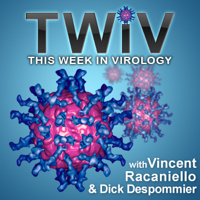October 3, 2009
This Week In Virology
Vincent Racaniello is a professor at the Microbiology department in Columbia University. He is extremely engaged with scientific disclosure on virology. Racaniello is also one of the authors of the book “Principles of Virology” and he could not continue transmitting such content only in books.
His blog, Virology, contains regular texts on several subjects, for example, influenza. With the appearance of Influenza A (H1N1) and a great demand from new visitors for the theme, he organized a specific page, the Influenza 101, where all the texts are listed. Here are some examples that I consider relevant:
Influenza virus RNA genome
The error-prone ways of RNA synthesis
Influenza virus re-assortment, then and now
How many people die from influenza?
Influenza hemagglutination inhibition assay
Well, if you do not have any time to read, you may listen about virology! Guess what, Racaniello has created a podcast together with Dick Despommier and Alan Dove. They make TWIV, This Week In Virology available in audio almost every week, a light and quite informative program that relies on several participants who are very well known in the field.
TWIV may be heard in the radio at home or in your way to work, and you may be sure to receive quality and original information. The program participants are able to discuss several subjects on virology with new ideas for the ones who are not from this field of knowledge and with new look for those who are already acquainted with the subject.
Here is a list of some episodes on Influenza:
TWiV 30: A/Mexico/4108/2009 (H1N1)
TWiV Special: Dr. Peter Palese [Please, pay special attention to this one, for Palese is one of the greatest authors on flu papers]
TWiV 31: Fever plus cough or sore throat
TWiV 34: Arsenic and facemasks [here there is a discussion on the effectiveness of protection masks]
TWiV 35: Much achoo about nothing
TWiV 40: Tamiflu in the water [a point to be discussed in public policies, how to distribute anti-viral medications, and the fact that they are stable in the environment after excreted by the body]
No Comments » Posted in: Uncategorized


